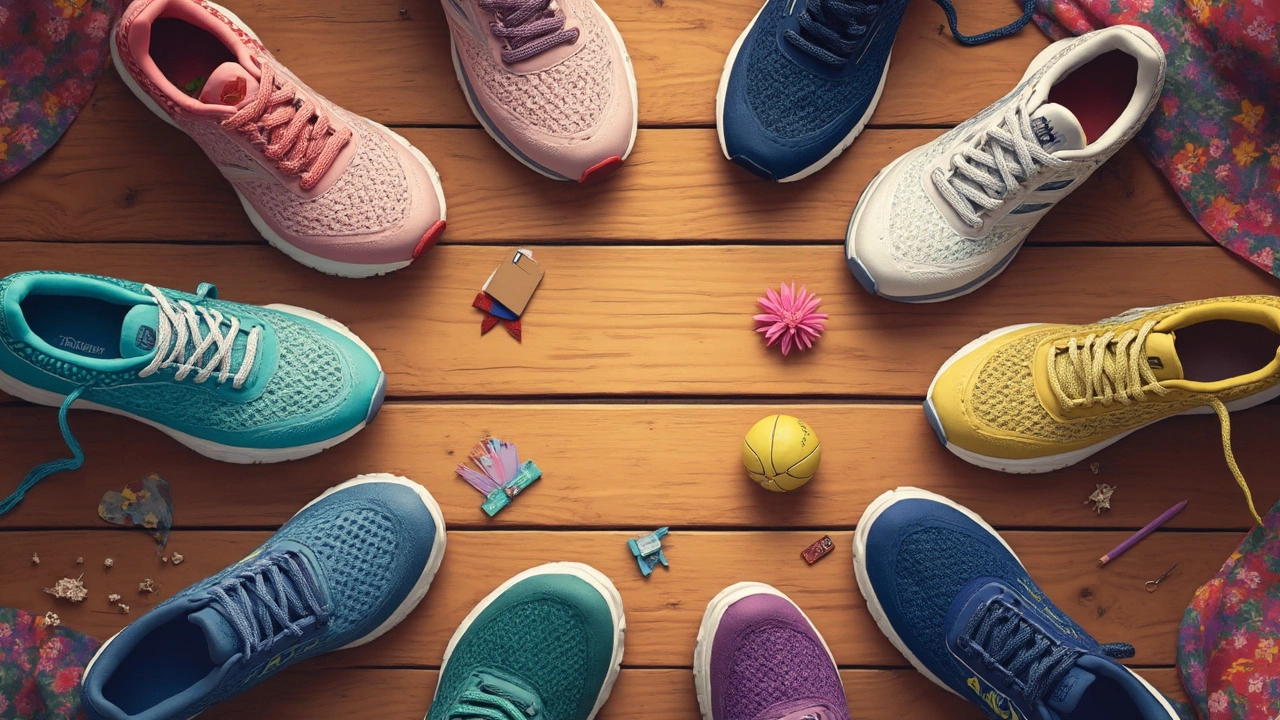Are Sneakers Sportswear? What Really Counts in the Sportswear World

Ever found yourself staring at a wall of sneakers and wondering if they all count as sportswear? You’re not alone. It gets confusing since pretty much everyone—athletes, students, even office workers—sport sneakers these days. The truth is, sneakers didn’t start out as a fashion statement. Their roots are deep in sports. Original designs were made to handle things like quick sprints, jumps, and long hours on your feet.
If you’re wondering what separates sportswear from just regular comfy shoes, it usually comes down to performance. Real sportswear sneakers pack in features like proper arch support, grippy soles, and breathable fabrics that actually help your body when you’re moving. Next time you’re shopping, don’t just look at colors and brands—peek inside the shoe. A true sports sneaker will usually mention shock absorption or specific activities like running or basketball on the tag.
- What Are Sneakers, Really?
- How Sneakers Became Sportswear
- Can You Wear Sneakers Everywhere?
- Tips for Picking the Right Sneakers
What Are Sneakers, Really?
Let’s break it down: sneakers are shoes with flexible, rubbery soles and a soft top, usually made of canvas, textile, or leather. Their real job? Keep your feet comfy and take the impact whether you’re on a court, trail, or sidewalk. The first sneaker, Keds, showed up in 1916, designed for quiet movement—hence the nickname "sneaker." Before that, most shoes had hard bottoms that clacked on the floor. Sneakers changed that game for good.
What separates athletic shoes from regular shoes? For starters, sneakers are built with bounce and grip. They often use EVA foam or gel in the midsoles to absorb shock (think running, jumping, or sudden stops). You’ll spot treads on the bottom—these patterns help with traction, so you don’t slip mid-sprint. They also fit snugly, which is crucial if you’re moving fast or pivoting a lot.
Here’s a quick breakdown of sneaker anatomy:
- Upper: This part covers the top of your foot. Materials like mesh keep it breathable, while leather makes it tougher.
- Midsole: Where all the magic happens. This is packed with foam or gel cushioning.
- Outsole: The bottom part, designed for grip. Rubber is the usual go-to here.
- Lacing System: Not just for looks—good laces lock you in so you don’t slide around.
And here’s a fun fact: The global sneakers market hit roughly $80 billion in sales last year, according to Statista. That means people all over the planet rely on these shoes for both sports and style.
How Sneakers Became Sportswear
It’s wild to think, but sneakers weren’t always cool or even common for everyday use. Way back in the late 1800s, the first rubber-soled shoes—people called them plimsolls—were designed mainly for walking comfortably and playing sports like tennis. They didn’t catch on instantly, but the real shift happened in the early 1900s when companies started putting extra thought into making shoes just for sports. Converse dropped their All Star basketball shoe in 1917, and it took off with athletes and coaches across the U.S.
That was just the start. In the 1970s, running became a major trend, and brands like Nike and Adidas got huge by focusing on high-performance athletic shoes. Their kicks featured things like better shock absorption, special grip for different sports, and lightweight materials. Nike even made air cushioning famous, making sneakers not just gear but something to show off. This was a massive push for sportswear—suddenly, specialized shoes became a must-have for athletes at every level.
Check this out: In 1984, Nike teamed up with Michael Jordan to release the Air Jordans. Not only did those shoes change what athletes wore on the court, they turned sneakers into fashion, too. Sales were so huge that sneaker drops and lines outside stores became pretty common.
Now, people buy athletic shoes for all sorts of reasons: fitness, lifestyle, and style. Some folks collect limited releases. Others want a pair that’ll go from gym class to coffee runs. But every legit sports brand still spends time and money on tech that starts with actual athletic needs. Here’s a quick glance at how sneakers broke out as sportswear over the decades:
- 1917: Converse debuts the All Star.
- 1950s–1960s: Keds and Adidas appeal to casual and sporty crowds.
- 1970s: Jogging boom drives innovation at Nike and Adidas.
- 1980s–90s: Tech like air cushions and cross-trainers takes off.
- 2000s-today: Collabs with athletes and designers make sneakers a centerpiece of sportswear and fashion.
So, yeah, sneakers absolutely count as sportswear—not just because of how they look, but because of how they’re built to handle sports from the ground up.

Can You Wear Sneakers Everywhere?
If you look around, sneakers seem to pop up at just about every event. Grocery runs, airports, classrooms—people rock them literally everywhere. But are sneakers really okay for every single occasion? Well, almost, but there are a few spots where they just don’t fit in.
The big draw with sneakers is their comfort and versatility. You're all set for a long walk, a quick gym session, or even standing in line for coffee. A lot of offices now have dress codes that allow clean, simple sneakers—especially in tech or creative jobs. Some schools actually require kids to wear athletic shoes for safety during recess or PE.
But before you toss out your dress shoes, here’s the deal. There are still places where sneakers don’t cut it. Think formal events: weddings, interviews for traditional jobs, or upscale restaurants often frown on them. Even if they look expensive, they’re still seen as too casual in some circles.
- Fun fact: In 2024, a survey by Statista found that 63% of adults in the U.S. owned at least one pair of sneakers meant for everyday use—not just sports. That’s a massive jump from a decade ago.
- Fashion insiders say that some luxury brands now sell sneakers that cost more than most people's rent, but that doesn’t mean you can wear them everywhere. For example, formal dress codes are still a thing in many high-end venues.
The bottom line? Sneakers work for most situations, especially if they're clean and match your outfit. But it’s smart to check the dress code for special events or jobs. When in doubt, dress up your sneakers with neat jeans or a casual blazer—or stash some flats or loafers in your bag just in case.
Tips for Picking the Right Sneakers
Shopping for sneakers can feel overwhelming with all the flashy options out there. If you want something that works as real sportswear—not just something cool for Instagram—here’s what you need to pay attention to.
- Fit and Comfort Matter Most: Your sneakers should hug your feet without squeezing. Try them on at the end of the day, when your feet are a little swollen, to get the best fit.
- Know Your Activity: Running, basketball, and walking sneakers are all made differently. Look for labels or ask staff about athletic shoes built for your sport or activity.
- Support and Cushioning: Good sneakers protect your feet and knees with features like arch support and shock-absorbing soles. If you have flat feet or high arches, don’t skip this detail.
- Grip Counts: Check the sole for patterns that offer solid traction if you’re going to use them for actual sports. Smooth soles can be slippery and are better for casual looks only.
- Breathable Materials: Feet sweat—a lot. Go for mesh or other breathable uppers to keep your feet cooler and help prevent blisters.
Here’s a handy breakdown from a popular athletic shoe review:
| Sneaker Type | Main Purpose | Key Features |
|---|---|---|
| Running | Cardio, Jogging | Lightweight, Extra Cushion |
| Basketball | Jumping, Quick Moves | Ankle Support, Durable Soles |
| Walking | Everyday Use | Flexible Sole, Moderate Cushion |
Lastly, don’t fall for just the big names. Sometimes, lesser-known brands have surprisingly awesome sneakers for less money. Try a few on, walk around the store, and pay attention to how they really feel. Your feet will thank you.